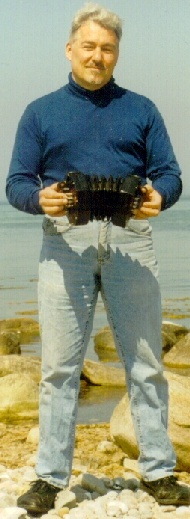Jim's Calendar
|
||||
 |
Performance Jim often performs alone, in the role of a traditional shantyman, leading the audience -- or "crew" -- to join in the choruses. He frequently accompanies himself on the concertina, but he especially likes the blending of the many voices of the audience that gives the authentic sound to sailors' songs. On concertina and whistle, he also plays the dance tunes and other melodies popular among sailors. In addition to his solo work, he often joins with other singers and musicians in ensembles of from two to half a dozen members, where together they build exciting harmonies and arrangements. Workshops Jim also gives workshops in the singing of shanties and other songs of the sea, both for leaders ("Shantyman") and followers ("Crew").
Shantykor (Shanty Choir) Besides the traditions of the solo shantyman and small ensembles in which Jim learned his trade, northern Europe has developed a tradition of large formal shanty choirs, often accompanied by accordions or other musical instruments. Jim views this as yet another aspect of a grand tradition and is proud to have been counted as a member of the Helsingør Sømandsforenings Shantykor (Elsinore Seaman's Union Shanty Choir) when his schedule permitted, in addition to his independent musical activities. Other Musical Activities Jim doesn't just sing shanties and sea songs. He performs songs and tunes from Ireland, England, Scotland, and elsewhere, compositions of his own, even jazz and classical pieces. He can equally well build a special performance around a specific theme or ad lib an entire program, according to what is needed. To learn more about Jim's varied musical activities, click here. |
|
||
| The Songs |
| |
Shanties |
| |
What are "shanties"? Stictly speaking, they are work songs, and songs for entertainment are not "shanties". Shanties are used by sailors to establish a working rhythm, with which they coordinate and concentrate the force of their actions. This coordination renders difficult tasks easy and makes possible many tasks that would be impossible with uncoordinated action. Led by a shantyman, the working crew join in singing "chorus parts" at regular intervals, insuring that they share the common rhythm. Their parts are simple, since they must concentrate on the work. The work is paramount, and the great variety of shanties reflects the variety of different tasks for which they are used. |
| |
Forebitters |
| |
"Forebitters", also known as "fo'c'sle songs" are just those songs the sailors sing when they're not working, described above as "other songs of the sea". Those names refer to the forward parts of the ship where they would congregate when off watch. Today, the recorded forebitters are almost exclusively about the sea in one way or another, though in fact the sailors might as often sing a music hall ditty or some other popular song of the day. Still, a contemporary audience expects songs about the sea in a concert of "sea songs", so that is generally what they'll get. |
| |
Tunes |
| |
Strictly speaking, tunes without words aren't "songs", but they certainly played a significant role in the sailors' musical expression. Whether on a lively dance tune or a plaintive "air", an instrument -- flute, squeezebox, fiddle, or what have you -- in the hands of an expressive player can truly be said to "speak" or "sing". And the sailors' repertoire was as broad as the oceans they sailed. |
| The Activities |
| |
Performances |
| |
Jim travels light. His concertina and whistle are all he needs, and he can even doing an entire evening of songs without them. He knows how to use a microphone, but he doesn't carry a sound system; if you expect him to use one (most do), please provide it. He can sing quietly and sweetly, but he can also make himself heard above the roar of a gale without assistance. (Real shantymen didn't have electronics.) If you want background music for conversation, look elsewhere; Jim's music is for listening! And it's worth listening to. The words of the songs are important, and most of them tell some kind of story. The melodies are also delightful, as are the variation and expression that Jim puts into his playing. If you want to clap along on the dance tunes, feel free, as long as the clapping doesn't become more important than the tune. And please don't feel shy about dancing to the music. |
| |
Workshops |
| |
|
| More about Jim Lucas | ||
|